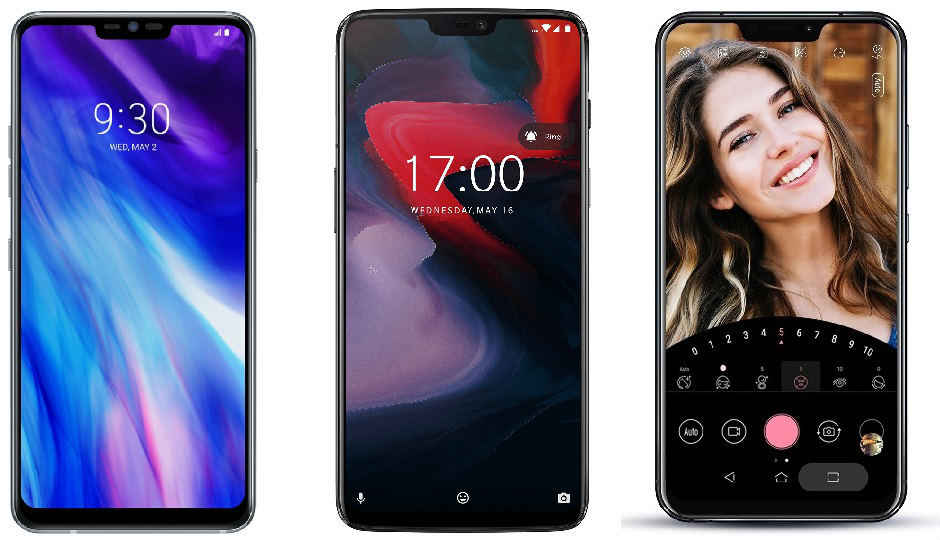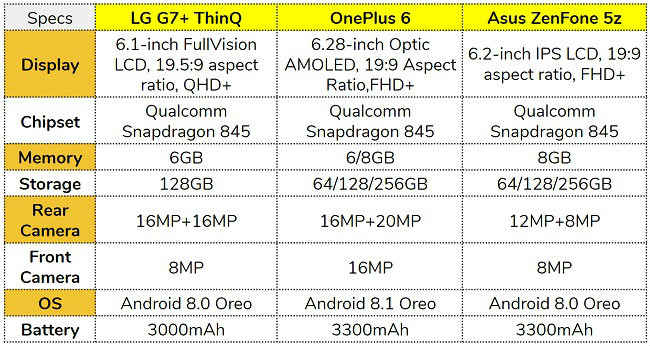Spec comparison: LG G7+ ThinQ vs OnePlus 6 vs Asus ZenFone 5z
Though late by two months, the new Korean flagship finally joins the game. How do the specs of the LG G7+ ThinQ hold up against the OnePlus 6 and Asus Zenfone 5z?

The rainy season of flagship smartphones that witnessed a downpour of new models last month hasn’t stopped, it seems. Though it might have been a late entry for LG, the G7+ ThinQ has finally joined the elite club and is rubbing shoulders with the likes of the OnePlus 6 and the Asus ZenFone 5z.
 Survey
SurveyLG’s new flagship, the G7+ ThinQ (along with the G7 ThinQ with lesser memory capacity), was announced back in May but has finally found its way to Indian shores in August. The successor to last year’s G6, the G7+ ThinQ features a glass design on the front and back and polished metal rims on the sides. LG says the phone is “MIL-STD 810G” rated by the US military. It also features a 6.1-inch FullVision 19.5:9 display. Powering it is no doubt the latest Qualcomm Snapdragon 845 chipset. Memory and storage are 6GB and 128GB respectively. Today, let’s see how its specs hold up against the competition: the OnePlus 6 and the Asus ZenFone 5z.
Under the Hood
All three phones offer the latest Qualcomm Snapdragon 845 chipset with a 6GB RAM option. The OnePlus 6 and the Asus ZenFone 5z offer a variant with 8GB of RAM while the LG G7+ ThinQ offers only 6GB. All three phones offer up to 256GB of internal storage, but only the LG G7+ ThinQ and ASUS ZenFone 5Z offer expandable storage. The LG offers up to 512 GB of expandable memory but the Asus offers twice that. All three phones employ an Adreno 630 GPU. The LG G7+ ThinQ and the Asus ZenFone 5z run Android 8.0 while the OnePlus 6 runs a newer Android 8.1 OS. With its ZenUI, the Asus strays the farthest away from the stock Android interface.
Build
The new LG G7+ ThinQ has a glass design on the front and back, is equipped with Corning Gorilla Glass 5, and shows off polished metal rims on the sides. It’s an IP68-rated smartphone that also has a seal of approval from the US military in that it’s “MIL-STD 810G” certified. The OnePlus 6(Review) also sports a glass design and gets an aluminium trim. It comes in four colours: Silk White, Midnight Black, Mirror Black, and OnePlus Red. In this respect, the Asus ZenFone 5z (Review) is no different. It too sports a glass design with 2.5D Corning Gorilla Glass and sells in Midnight Blue and Meteor Silver.
Display
Smartphones are sporting increasingly taller displays. The once-considered tall 18:9 aspect ratio is getting taller and taller, thanks to slimmer bezels and notches to make way for a better gaming and video-watching experience. The LG G7+ has a 19.5:9 6.1-inch FullVision QHD+ (3120 x 1440 pixels) LCD panel. With LG’s Super Bright Display technology, the G7+ThinQ can be viewed easily even under direct sunlight with brightness up to an industry-leading 1,000 nits, displaying 100 percent of the DCI-P3 colour gamut, which is much wider than sRGB. In comparison, the OnePlus 6’s 19:9 display is slightly larger at 6.28 inches and has a lower resolution of 2280 x 1080 pixels. The Asus ZenFone 5z too has a comparable 19:9 6.2-inch display with a slightly lower resolution of 2246 x 1080 pixels and a max brightness of 550 nits. Additionally, the LG G7+ ThinQ is the only one of the three that supports not only HDR10, but also Dolby Vision standard for HDR video.
Camera
In the camera department, we see that the new LG G7+ ThinQ’s rear camera setup consists of a 16-megapixel standard lens and a 16-megapixel super wide angle lens. The front camera is a modest 8-megapixel shooter. The camera offers 19 shooting modes. LG claims the phone now offers enhanced low light photography. The LG G7+ThinQ is one of the first smartphones to get the upcoming Google Lens feature. Located just below the volume rocker, is a button that launches the phone’s AI functions. A single press of this button will launch the Google Assistant while two quick presses will launch Google Lens. Naturally, the OnePlus too has a dual camera setup: a 16-megapixel and a 20-megapixel sensor, with the latter being used for portrait shots and low light photos. The Asus ZenFone 5z uses a 12-megapixel sensor along with an 8-megapixel 120-degree-wide sensor. The OnePlus has the largest front camera sensor at 16 megapixels; it’s double of what the other two offer.
Other Features
At 3,000mAh the LG G7+ ThinQ employs the smallest battery of the three models. The OnePlus 6 and the Asus ZenFone 5z employ a 3,300mAh battery. All three phones are equipped with fast-charging capability; the G7+ ThinQ and ZenFone 5z use QuickCharge 3.0 while the OnePlus 6 sticks to a proprietary Fast Charge (previously Dash Charge) technology. While the OnePlus 6 is designed to survive the odd splash of water, the Asus ZenFone 5Z is not built with water or dust-resistance in mind. The LG G7+ ThinQ is IP68-rated and gets a “MIL-STD 810G” certificate. The OnePlus 6 uses no special technology for audio output but the LG G7+ ThinQ and the Asus ZenFone 5z feature DTS:X (only through headphones for the ZenFone). Apart from the usual elements in the box, OnePlus offers a pre-installed screen protector and a translucent case for the smartphone, but no earphones. Asus offers a pair of ZenEar Pro Hi-Res headsets and a clear soft bumper case for the smartphone while LG offers only a pair of headsets.
In Conclusion
While we have expected OnePlus to deliver smartphones with flagship specs paired with a relatively cheaper price tag, the Asus was a surprise entrant into this segment. Both the phones run on the latest Qualcomm Snapdragon processor and offer copious amounts of RAM and internal storage, but do end up cutting some features from the spec sheet which allows them to be sold at their low price. LG, however, is further shaking up this space, with the G7+ ThinQ which is priced rather competitively, and brings every premium feature with it that is missing on the OnePlus and Asus offerings, that is, HDR display, QHD resolution, IP-ratings and a Quad-DAC. While it appears to be quiet a beast on paper, whether it can stand up to the Flagship killer is something we will find out in our detailed review of the phone.
Vignesh Giridharan
Progressively identifies more with the term ‘legacy device’ as time marches on. View Full Profile
